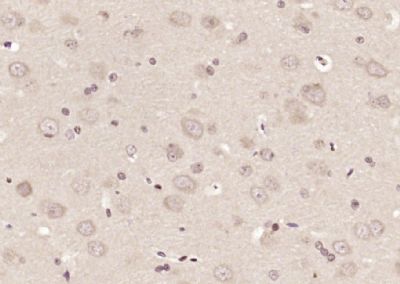C1D Polyclonal Antibody
Purified Rabbit Polyclonal Antibody (Pab)
- 产品详情
- 实验流程
Application
| IHC-P, IHC-F, IF, ICC, E |
|---|---|
| Primary Accession | Q13901 |
| Reactivity | Rat, Pig, Dog, Bovine |
| Host | Rabbit |
| Clonality | Polyclonal |
| Calculated MW | 16019 Da |
| Physical State | Liquid |
| Immunogen | KLH conjugated synthetic peptide derived from human C1D |
| Epitope Specificity | 51-141/141 |
| Isotype | IgG |
| Purity | affinity purified by Protein A |
| Buffer | 0.01M TBS (pH7.4) with 1% BSA, 0.02% Proclin300 and 50% Glycerol. |
| SUBCELLULAR LOCATION | Cytoplasm. Nucleus > nucleolus. EXOSC10 is required for nucleolar localization. |
| SIMILARITY | Belongs to the C1D family. |
| Post-translational modifications | Phosphorylated by PRKDC. |
| Important Note | This product as supplied is intended for research use only, not for use in human, therapeutic or diagnostic applications. |
| Background Descriptions | C1D, also known as SUNCOR, is a nuclear DNA-binding protein that localizes to the nucleus and cytoplasm and participates in processing of the 5.8S rRNA. Expressed ubiquitously with highest expression in thyroid, salivary gland, hippocampus and medulla oblongata, C1D forms a multi-protein complex with MPP6 (M phase phosphoprotein 6) and EXOSC10 (exosome component 10). This complex is responsible, in part, for recruiting the exosome to pre-rRNA and it functions to mediate 3’-5’ rRNA processing. Additionally, C1D can induce transcriptional repression and apoptosis through interaction with Rev-erbα (V-erbA-related protein EAR-1)/TRβ (thyroid hormone receptor β) and p53, respectively. C1D, a 141 amino acid protein, is also implicated in DNA repair mechanisms, as well as DNA-PK (DNA-dependent protein kinase) activation. |
| Gene ID | 10438 |
|---|---|
| Other Names | Nuclear nucleic acid-binding protein C1D, hC1D, C1D |
| Target/Specificity | Ubiquitous. Expressed at very high levels in the hippocampus, medulla oblongata, mammary gland, thyroid and salivary gland. Expressed at high levels in the fetal; lung, liver and kidney. Expressed at low levels in skeletal muscle, appendix, heart, lung and colon. |
| Dilution | IHC-P=1:100-500,IHC-F=1:100-500,ICC=1:100-500,IF=1:100-500,ELISA=1:5000-10000 |
| Format | 0.01M TBS(pH7.4) with 1% BSA, 0.09% (W/V) sodium azide and 50% Glyce |
| Storage | Store at -20 °C for one year. Avoid repeated freeze/thaw cycles. When reconstituted in sterile pH 7.4 0.01M PBS or diluent of antibody the antibody is stable for at least two weeks at 2-4 °C. |
| Name | C1D |
|---|---|
| Function | Plays a role in the recruitment of the RNA exosome complex to pre-rRNA to mediate the 3'-5' end processing of the 5.8S rRNA; this function may include MPHOSPH6. Can activate PRKDC not only in the presence of linear DNA but also in the presence of supercoiled DNA. Can induce apoptosis in a p53/TP53 dependent manner. May regulate the TRAX/TSN complex formation. Potentiates transcriptional repression by NR1D1 and THRB (By similarity). |
| Cellular Location | Nucleus. Cytoplasm. Nucleus, nucleolus. Note=EXOSC10 is required for nucleolar localization (PubMed:17412707). Colocalizes with TSNAX in the nucleus (PubMed:11801738). |
| Tissue Location | Ubiquitous. Expressed at very high levels in the hippocampus, medulla oblongata, mammary gland, thyroid and salivary gland. Expressed at high levels in the fetal; lung, liver and kidney Expressed at low levels in skeletal muscle, appendix, heart, lung and colon. |
Research Areas
For Research Use Only. Not For Use In Diagnostic Procedures.
Application Protocols
Provided below are standard protocols that you may find useful for product applications.
终于等到您。ABCEPTA(百远生物)抗体产品。
点击下方“我要评价 ”按钮提交您的反馈信息,您的反馈和评价是我们最宝贵的财富之一,
我们将在1-3个工作日内处理您的反馈信息。
如有疑问,联系:0512-88856768 tech-china@abcepta.com.
¥ 1,500.00
Cat# AP55297























 癌症的基本特征包括细胞增殖、血管生成、迁移、凋亡逃避机制和细胞永生等。找到癌症发生过程中这些通路的关键标记物和对应的抗体用于检测至关重要。
癌症的基本特征包括细胞增殖、血管生成、迁移、凋亡逃避机制和细胞永生等。找到癌症发生过程中这些通路的关键标记物和对应的抗体用于检测至关重要。 为您推荐一个泛素化位点预测神器——泛素化分析工具,可以为您的蛋白的泛素化位点作出预测和评分。
为您推荐一个泛素化位点预测神器——泛素化分析工具,可以为您的蛋白的泛素化位点作出预测和评分。 细胞自噬受体图形绘图工具为你的蛋白的细胞受体结合位点作出预测和评分,识别结合到自噬通路中的蛋白是非常重要的,便于让我们理解自噬在正常生理、病理过程中的作用,如发育、细胞分化、神经退化性疾病、压力条件下、感染和癌症。
细胞自噬受体图形绘图工具为你的蛋白的细胞受体结合位点作出预测和评分,识别结合到自噬通路中的蛋白是非常重要的,便于让我们理解自噬在正常生理、病理过程中的作用,如发育、细胞分化、神经退化性疾病、压力条件下、感染和癌症。






